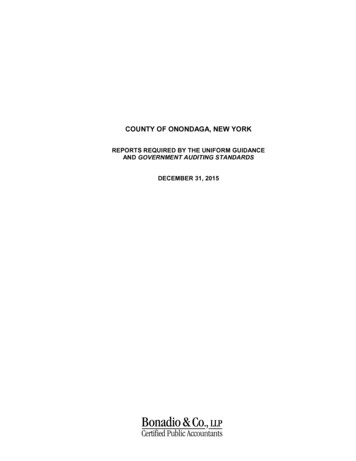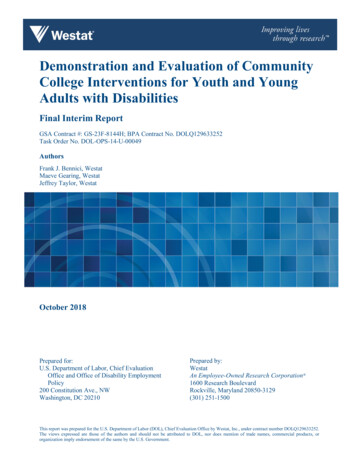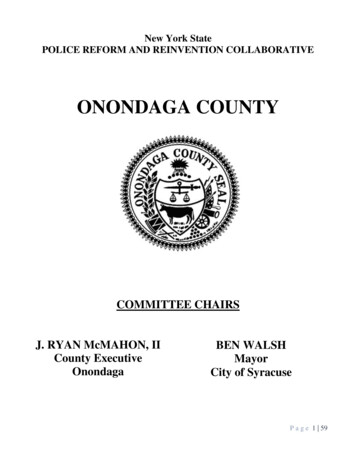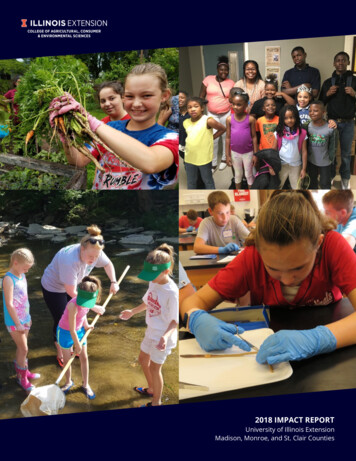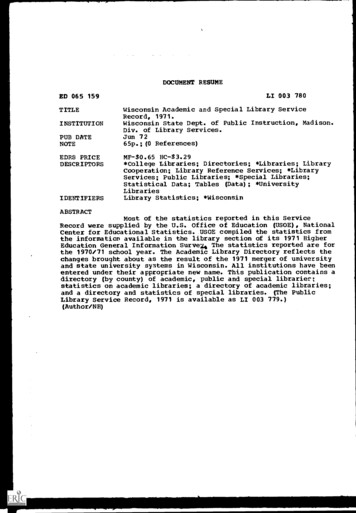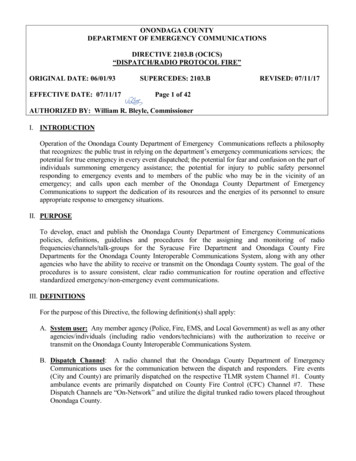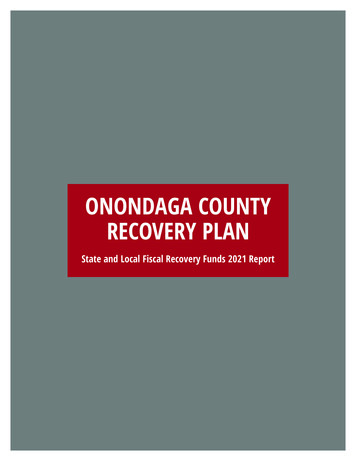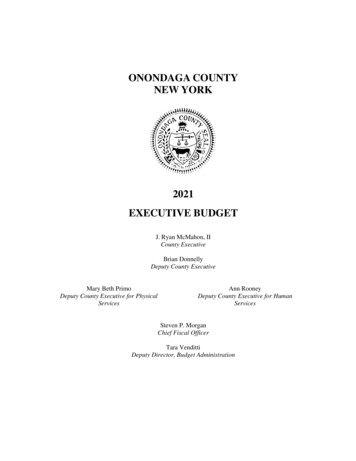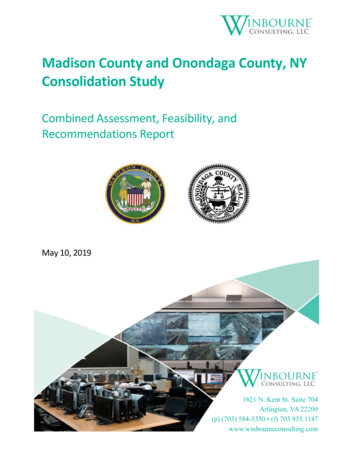
Transcription
Madison County and Onondaga County, NYConsolidation StudyCombined Assessment, Feasibility, andRecommendations ReportMay 10, 20191621 N. Kent St. Suite 704Arlington, VA 22209(p) (703) 584-5350 (f) 703.935.1147www.winbourneconsulting.com
Madison County and Onondaga County, NYConsolidation StudyExecutive SummaryIntroductionAcross the country, Public Safety Answering Point (PSAP) consolidations are occurring on aregional, city, county, or multiple-agency basis. These consolidations often result in tangibleimprovements in service and costs savings by combining 9-1-1 call taking and/or emergencydispatch services, and sharing technology, such as Computer Aided Dispatch (CAD).Madison County and Onondaga County have tasked Winbourne Consulting with determiningthe benefits of a potential consolidation of their 9-1-1 Centers, including whether aconsolidation would improve service to citizens and increase the safety of First Responders. TheCounties’ leadership have both clearly stated their commitment to working together in the bestinterests of the citizens, First Responders, and staff, in the consolidation model that has themost impact. There is already a strong precedent for the two counties working together, asseen with the Central New York Interoperable Communications Consortium (CNYICC) modelthat includes the shared digital trunked radio system master site, run by Onondaga County andshared with the region, to include Madison.For the reasons outlined in this report, Winbourne Consulting believes that full consolidationbetween Madison and Onondaga Counties’ 9-1-1 Centers provides significant service levelimprovements to Madison County citizens and First Responders. We recommend a phasedapproach with specific steps that will realize immediate benefits as the counties transition to afull consolidation model.Our MethodologyAs part of our analysis for this Consolidation Study, we solicited and received surveys fromMadison and Onondaga Counties’ 9-1-1 staff and the First Responder communities, conductedstakeholder interviews, and analyzed operations of both Centers. From this information wedeveloped the Phase 1: Assessment and Gap Analysis Report, which outlines the similarities anddifferences between the two centers, and this Phase 2: Evaluation and RecommendationsReport, which provides significant detail on consolidation options, advantages andconsiderations of each, and recommendations to meet the goals of each county.Consolidation ModelsThere are multiple consolidation models used within the 9-1-1 industry today, with nuancedvariations among them. After conducting the Phase 1 Assessment and Gap Analysis Report forMadison and Onondaga Counties, Winbourne Consulting determined that two potential modelsof consolidation could benefit this environment and the impacts of each have been evaluated.1 Page
Madison County and Onondaga County, NYConsolidation StudyShared Services ModelA “shared services model” for Onondaga and Madison Counties is defined as each countymaintaining their separate physical locations but sharing technology, mapping, and whereappropriate, policies and procedures to implement “best practices.” Winbourne Consulting hasdetermined that this model is: Operationally and technically feasible; Financially feasible with clear near and long-term benefits; and Politically feasible, with broad support from the stakeholder communityWinbourne Consulting has determined that this model has significant benefits to servicedelivery for citizens and First Responders: Improved First Responder Safety. In a shared services model, Madison County firstresponders would have access to Onondaga County’s state-of-the-art Computer AidedDispatch (CAD) system to improve situational awareness and officer safety, and ensureaccurate communications from the field. Improved Response to Citizens. In a shared services model, Madison County citizens willbenefit from better coordination of mutual aid efforts, especially in the volunteer fireservice. Citizens would be better served with shared mapping between the two counties,which could lead to responders finding the 9-1-1 callers quicker. This faster response timecan save lives.Centralized Consolidation ModelA “full consolidation model” would move Madison County’s 9-1-1 services into OnondagaCounty Department of Emergency Communications’ primary (and backup) facility, with sharedmanagement and resources. Winbourne Consulting has determined that this model is: Operationally feasible but provides challenges in personnel retention;Technically feasible with upfront capital expenses and likely ongoing operational savings;Financially feasible especially when implemented after the Shared Services Model; andPolitically feasible as an end-goal in a phased consolidation approach but would meet witha high level of resistance from stakeholders in the short-term unless there were aconcerted program to clear up misperceptions and engage and involve stakeholders, andstructure a Governance model to ensure that Madison County’s needs are addressed.Winbourne Consulting has determined that the full consolidation model has significant benefitsto service delivery for citizens and First Responders: Enhanced First Responder Safety. Madison County First Responders would benefit from allthe advantages of the Shared CAD system described in the Shared Services Model above. Inaddition, Madison County First Responders will be better served by dispatchers who are2 Page
Madison County and Onondaga County, NYConsolidation Studynot also responsible for answering 9-1-1 calls, in alignment with the Onondaga Countymodel, and dispatched based the “best practices” of Onondaga County. Improved Response to Citizens. In addition to all the benefits identified in the SharedServices Model, Madison County residents and public safety agencies would benefit fromthe use of many Onondaga County policies and procedures, which are compliant withindustry standards.RecommendationsWinbourne Consulting recommends Madison and Onondaga Counties gradually work toward afull consolidation of their 9-1-1 Centers. Our research indicates that efficiencies in bothoperations and cost will be realized, and the safety of First Responders, and the ability toprovide excellent emergency response service to citizens, will be improved with a fullconsolidation.We also realize that given the political and operational concerns surrounding a fullconsolidation, it is probable that this recommendation will take between two – four (2-4) yearsto implement. Therefore, we are recommending a multi-phased process, to be implementedover time, providing near-term benefits with operational improvements and shared technology,and longer-term cost savings and service level standardization among the counties.Winbourne Consulting believes that this phased approach will benefit all the stakeholders, andwill enable the jurisdictions to: Become more familiar with one another;Develop standardized training and procedures;Standardize technology (e.g., computer aided dispatch, mapping);Develop standardized mapping updates and dispatching processes; andEstablish the necessary governance agreements for the longer term consolidation of thetwo 9-1-1 centers.We have outlined the multi-phase approach that we recommend for Madison and OnondagaCounties, to be accomplished roughly in this order:1. Implement immediate Operational changes in Madison Countya. Develop and Train to a more comprehensive Policy Manual to improve operational bestpractices in Madison County.i.Update current policies to reflect the best-practices as identified by industrystandards organizations.ii. Create additional policies as needed, to address gaps and the current inadequatedepth of content for some of Madison County’s Operational policies.3 Page
Madison County and Onondaga County, NYConsolidation Studyiii. Comply with all policies with a consistent and improved training process for currentand new-hire call center personnel.b. Improve communications between Madison County Dispatchers and First Responders toenhance ongoing interactions with Madison County First Responders and encouragemore involvement of First Responders in 911 quality assurance.c. Implement a good Quality Assurance/Quality Improvement (QA/QI) program forMadison County Police and Fire incidents, based on industry standards for QA/QI.d. Increase staffing to add position for Assistant Director – Operations, with responsibilityfor QA/QI, and training. Consider adding two shift Supervisors to meet National FireProtection Association (NFPA) standards. We have estimated the cost of adding theneeded three (3) personnel for these roles at approximately 173K annually.2. Establish Governance model for sharing data. In preparation for Recommendation #3below, it will be necessary to establish a governance model to address the sharing of CADdata.3. Implement shared Computer Aided Dispatch (CAD). We recommend that Madison Countyutilize Onondaga County’s Hexagon/Intergraph CAD solution. A detailed Implementationplan to execute a shared CAD environment should be developed to further define thegovernance, funding, technical, and operational components necessary to successfullyimplement a shared CAD system between the two counties.4. Expand Onondaga County’s Backup Operations Center (BOC). In a full consolidation model,the BOC will become the backup center for all 9-1-1 and non-emergency calls from MadisonCounty. In preparation for the full consolidation recommendation, #6 below, it isrecommended that further discussions occur between both Counties on the desired optionsfor expanding the BOC, and begin the process of securing potential grant funding throughNYS Department of State’s Municipal Restructuring Fund grant to cover these non-recurringcosts.5. Develop Governance model for full consolidation. One of the most critical aspects of ashared technology or services project is the development of an effective governance modelto ensure that stakeholders have input on the amount of control, expectations, andoutcome of a consolidation project. We recommend that Madison County establish aCounty 9-1-1 Board, under Emergency Management, and also provide representation toOnondaga County’s Policy Review and Operations Committee (PROC).6. Implement Full Consolidation. Winbourne Consulting believes that the stakeholders inMadison County will be best served by a Full Consolidation of Madison and Onondaga4 Page
Madison County and Onondaga County, NYConsolidation StudyCounties, implemented over a two – four (2-4) year time period during which the precedingsteps can be accomplished in preparation.The exact timing of this consolidation may align with the implementation of Next Generation9-1-1 in New York State, ensuring the most efficient upgrade of technology in both Counties.We recommend that salary and benefits be reviewed to make sure that neither County’spersonnel is harmed in the process of fully consolidating.We recommend that following the full consolidation, Madison County dispatchers still continueto dispatch Madison County Police, Fire, and EMS calls for a period of time to maintainconsistency of service. Lateral movement can occur later in the process, but for the initialperiod, their knowledge of the local area will benefit citizens and the First Respondercommunity. We further recommend that a complete line by line budget comparison for eachcenter be conducted prior to an agreement to move to full consolidation.Winbourne Consulting thanks the stakeholders of both Madison County and Onondaga Countyfor their sincere and enthusiastic participation in this Consolidation Study.5 Page
Expand Onondaga County's Backup Operations Center (BOC). In a full consolidation model, the BOC will become the backup center for all 9-1-1 and non-emergency calls from Madison County. In preparation for the full consolidation recommendation, #6 below, it is recommended that further discussions occur between both Counties on the desired options
